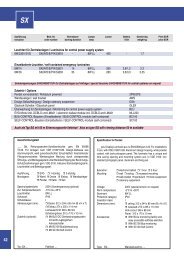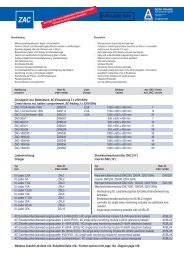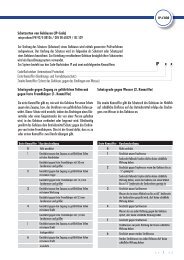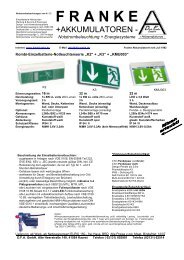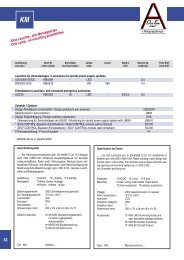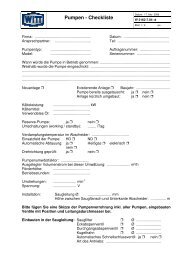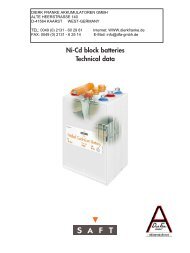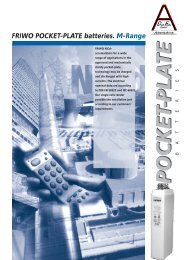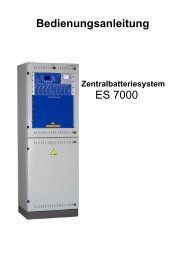Hochdruckschwimmer- Regler Montage- und ... - KomMa
Hochdruckschwimmer- Regler Montage- und ... - KomMa
Hochdruckschwimmer- Regler Montage- und ... - KomMa
Sie wollen auch ein ePaper? Erhöhen Sie die Reichweite Ihrer Titel.
YUMPU macht aus Druck-PDFs automatisch weboptimierte ePaper, die Google liebt.
10. BETRIEB 10. OPERATION<br />
Der <strong>Hochdruckschwimmer</strong>-<strong>Regler</strong> arbeitet völlig selbstständig<br />
<strong>und</strong> bedarf keiner weiteren Bedienung.<br />
The high-pressure regulator operates automatically and<br />
does not require further attention.<br />
11. WARTUNG UND INSTANDHALTUNG 11. SERVICE AND MAINTANANCE<br />
Der eingebaute Schieber unterliegt kaum Verschleiß <strong>und</strong> die<br />
kontinuierliche Selbstreinigung der Schiebersteuerung<br />
macht Wartungsarbeiten normalerweise überflüssig.<br />
The low friction slide block offers low wear and continuous<br />
self-cleaning of the orifice area, which normally requires no<br />
further maintenance.<br />
Vor dem Öffnen des <strong>Hochdruckschwimmer</strong>-<strong>Regler</strong>s ist dieser<br />
vom Kältemittel zu entleeren.<br />
Wenn Wartungsarbeiten am <strong>Hochdruckschwimmer</strong>-<br />
<strong>Regler</strong> HR durchgeführt werden sollen, muss das<br />
Gehäuse drucklos sein <strong>und</strong> das Kältemittel vollständig<br />
abgesaugt sein, bevor die Verschraubungen gelöst<br />
werden!<br />
Beim Öffnen der <strong>Regler</strong> kann es zu einer plötzlichen<br />
Verdampfung von eingeschlossenem Kältemittel<br />
kommen! Deshalb unbedingt Schutzkleidung tragen!<br />
Entfernen Sie auf keinen Fall alle Schrauben, wenn<br />
noch Kältemittel oder Druck vorhanden ist.<br />
Beim Zusammenbau des <strong>Regler</strong>s ist auf Vorhandensein<br />
aller Dichtungen <strong>und</strong> deren Unversehrtheit zu achten. Es<br />
wird empfohlen die Dichtungen nach jedem Öffnen auszuwechseln!<br />
Ist die Demontage von Sicherheitseinrichtungen beim Rüsten,<br />
Warten <strong>und</strong> Instandsetzen erforderlich, haben unmittelbar<br />
nach Abschluss der Arbeiten die Remontage <strong>und</strong> Überprüfung<br />
der Sicherheitseinrichtungen zu erfolgen!<br />
Before opening the high side float regulator any refrigerant<br />
need to taken out.<br />
When the high-pressure float regulator HR is to be<br />
maintained, the housing must be completely depressurised<br />
and all the refrigerant entirely removed,<br />
before loosening any screws and opening up!<br />
During opening up a sudden boiling of residue refrigerant<br />
may occur. Therefore wear the required<br />
safety clothing! Do not remove all the screws until<br />
you are sure no residue refrigerant or pressure<br />
exists.<br />
Upon re-assembly take care that all gaskets are in place<br />
and in good condition. It is recommended to replace all<br />
gasket each time the float regulator has been opened.<br />
If you have to disassemble any safety devices for maintenance<br />
or repair make sure that on completion the reassembly<br />
and proper functions are checked.<br />
11.1 FUNKTIONSKONTROLLE 11.1 FUNCTIONING CHECK<br />
Alle <strong>Regler</strong> haben einen von außen zu betätigenden Hebel,<br />
der ein Anheben der Schwimmerkugel ermöglicht. Dadurch<br />
kann der <strong>Regler</strong> bewusst geöffnet werden, um dessen Funktion<br />
zu überprüfen.<br />
All float regulators are provided with a lever that can be<br />
operated externally to lift the float. The regulator can be<br />
opened or closed that way to check that it is functioning<br />
correctly.<br />
11.2 AUSTAUSCH DES SCHWIMMKÖRPERS 11.2 REPLACING THE FLOAT BALL<br />
Beachten Sie beim Ausbau unbedingt die lokalen Unfall<br />
Verhütungs-Vorschriften. Beachten Sie insbesondere folgendes:<br />
• Prüfen Sie Fluchtmöglichkeiten, um im Notfall schnell<br />
die Gefahrenstelle verlassen zu können.<br />
• Sorgen Sie aus Sicherheitsgründen für Hilfe bei der<br />
Demontage des <strong>Regler</strong>s.<br />
• Sorgen Sie für geeignete Schutzkleidung, mindestens<br />
für eine Sicherheitsbrille <strong>und</strong> Handschuhe <strong>und</strong> bei Verwendung<br />
von NH3 für eine griffbereite Gasmaske.<br />
Follow all national and local safety requirements and<br />
codes of practice when removing the float. Please take<br />
particular care of the following:<br />
• Check the plant room layout and exit doors so you<br />
can evacuate the area quickly in case of an emergency.<br />
• Seek assistance to handle and remove the float<br />
• Wear the correct protective safety clothing, as a minimum<br />
use safety goggles and gloves, in case of NH 3<br />
have a safety gas mask within easy reach<br />
Gehen Sie beim Austausch wie folgt vor :<br />
• Schließen Sie das Eintrittsventil<br />
• Arretieren Sie den Schwimmkörper, indem Sie den<br />
Hebel nach oben drehen<br />
• Warten Sie bis sich das Kältemittel zur ND-Seite entspannt<br />
hat<br />
• Schließen Sie nun auch das Austrittsventil<br />
• Lassen Sie verbleibendes Kältemittel <strong>und</strong> Öl vorsichtig<br />
über das untere Ablassventil EA 10 GB ab<br />
• Falls erforderlich, Spülen Sie das Gehäuse mit Stickstoff<br />
When exchanging the float please carry out the following<br />
steps :<br />
• Close the inlet valve<br />
• Lock the float by turning the lever upwards<br />
• Wait until all refrigerant is released to the low pressure<br />
side<br />
• Now close the outlet valve<br />
• Drain any remaining refrigerant and oil carefully<br />
through the bottom mounted drain valve EA 10 GB<br />
• If necessary purge the regulator housing with nitrogen<br />
36



